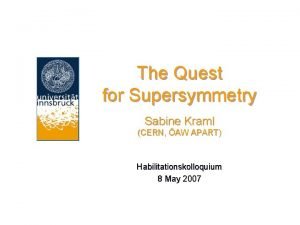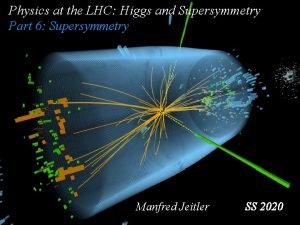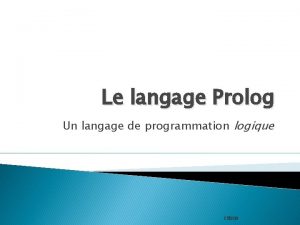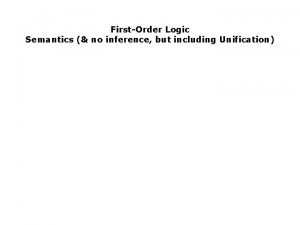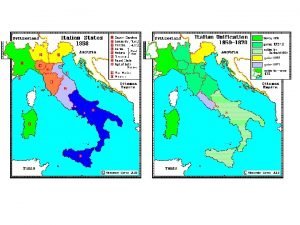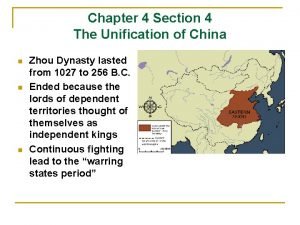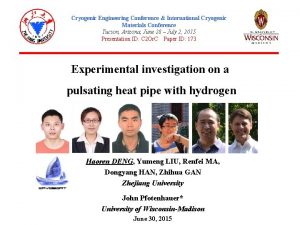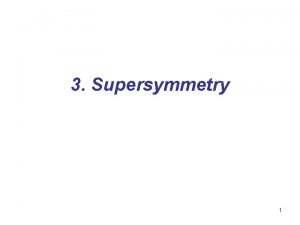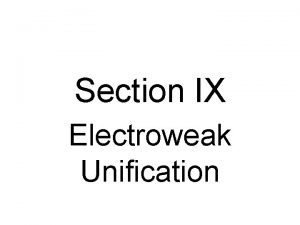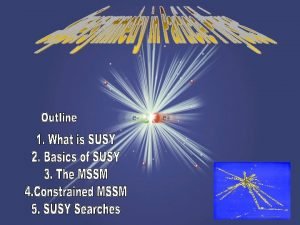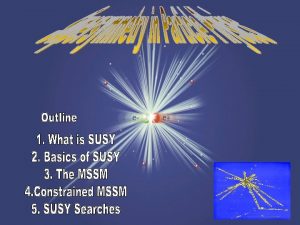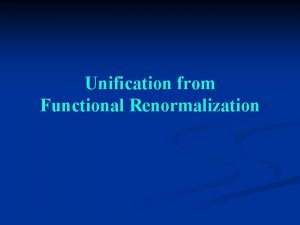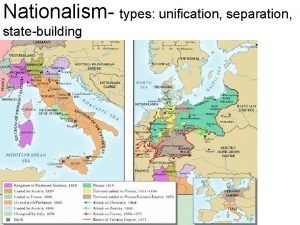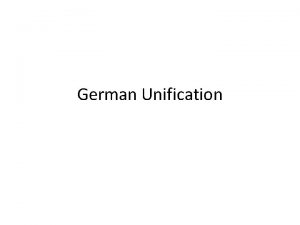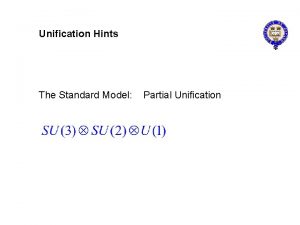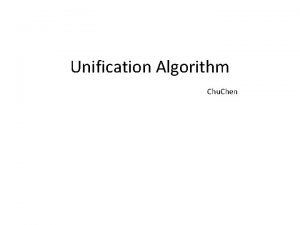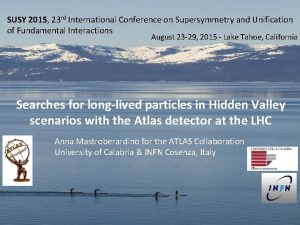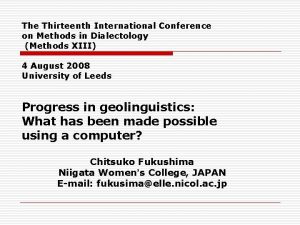Thirteenth International Conference on Supersymmetry and Unification of


























- Slides: 26

Thirteenth International Conference on Supersymmetry and Unification of Fundamental Interactions Searches for New Phenomena : non-SUSY scenarios Emmanuelle PEREZ DESY & CEA-Saclay, DSM / DAPNIA / Spp • Searches in well-known final states : • indirect effects • resonances • Searches in rare SM final states • Funny experimental signatures… SUSY ’ 05, Durham 23 July 2005

Searches for New Physics : why & where Mechanism of the EW symmetry breaking ? Higgs (i. e. fundamental scalar) ? Find it… structure of the Higgs sector ? solution of the hierarchy problem ? SUSY MPl ? “Little Higgs” 10 Te. V ? extra dimensions no hierarchy ? no Higgs ? Dynamical breaking ? ( H ~ condensate ) extra-dim physics ? ( H ~ Gauge Field|4 d ) In most scenarios, new physics is expected at the Te. V scale. Also hoped for, that NP might answer some of the questions unexplained by the SM or by SM+SUSY (e. g. quantization of EM charge, particle masses etc) Various strategies to track new physics, e. g. : - high precision measurements ( need good theoretical control ) - rare decays (K & B) , LFV processes - searches at high energy colliders LEP, Tevatron, HERA Some complementarities between these different approaches and between measurements at the three high energy colliders. E. Perez SUSY’ 05, 23 / 07 / 05

Good performances of our facilities ! _ Tevatron pp, s = 1. 96 Te. V CDF & D 0 Run I (92 -96) : 110 pb-1 / exp Run II (since 01) 1 fb-1 delivered HERA e p, s = 320 Ge. V H 1 & ZEUS until summer 2000 : 120 pb-1 / exp (mainly e+ p) 1000 ! 2005 2003 -04 Analyses presented here 200 -450 pb-1 of Run II data (2002 - 2004) HERA-II sample > HERA-I HERA I+II analyses : up to 200 pb-1 + LEP data ! Very relevant constraints on NP ! some final combinations are still to come + B-factories : Ba. Bar and Belle collected 350 millions of BB pairs ! E. Perez SUSY’ 05, 23 / 07 / 05

Some news from the Standard Model… • sin 2 W at Nu. Tev ? Differs by 3 from global SM analysis Not clear… theoretical uncertainty ? e. g. asymmetry in s-s, violaton of isospin in parton distributions due to QED effects ? ? • (g-2) ? Very precise measurement at BNL (0. 5 ppm !) Above the SM value (2. 7 ) if low energy e+e- data are used for a HAD - e+e- 4 at Ba. Bar using ISR photons : somehow in-between e+e- & - (e+e- ) by KLOE at DA NE ( s 1 Ge. V) : confirms the other e+e- meas. … KLOE, hep-ex/0407048 Burkhardt & Pietrzyk, hep-ph/0506323 • New value of Vus : New measurements from KTe. V and KLOE unitarity restored ! • sin(2 ) from b s penguins : WA. from charmonium modes went down (LP’ 05) Discrepancies seem to get smaller … E. Perez • Still discrepancies in polarisation data in B decays into vector meson when penguins are involved… could be explained by final state interactions ? Belle, PRL 94 (2005) 221804 4 SUSY’ 05, 23 / 07 / 05

Our backgrounds for NP searches at colliders NC(Q 2>400 Ge. V 2) ~ 1000 pb CC(Q 2>400 Ge. V 2) ~ 25 pb Blue = not yet observed NC Tevatron HERA Single top tt CC Wbb Q 2 (Ge. V 2) WZ l ll LEP In this talk : From well-known processes to rare & very rare processes WZ+ZZ l , llll, ll E. Perez 5 SUSY’ 05, 23 / 07 / 05

d / (d )SM A lot to learn from “bread & butter” @ colliders First simple example : Rq < 10 -18 m E. g. DIS as the golden process to study the structure of matter : (at HERA, Q 2 max 105 Ge. V 2) assign a finite size to the EW charge distributions. 2 r < > 2 f(Q ) = 1 Q 6 2 2 nd “generic” example : assume Q 2 (Ge. V 2) that the scale of NP is large, parameterize the effects of NP as a four-fermion interaction : _ _ ( ei )( qj ) Typical bounds > 5 – 20 Te. V Next slides : examples of model-dependent constraints E. Perez 6 SUSY’ 05, 23 / 07 / 05

Dileptons, , DIS & Extra Dim. Scenarios Interference of KK exchange with SM processes (ee, , , DIS) • Large extra-dim (AADD) : tower of gravitons G(k) q q , Z l G(k) l - ee & at LEP : MS > 1. 34 Te. V - DIS at HERA : MS > 0. 82 Te. V DY, QCD “fake” DY D 0 Run II + Run I, ee & : MS > 1. 43 Te. V D 0 Run II Prelim, 200 pb-1 SM SM + signal, Mc = 500 Ge. V E. Perez ee Most stringent collider bound: Tevatron 2 fb-1 : MS up to 2 Te. V QCD bckgd At high mass : e. g. ll, at Tevatron : Effective coupling : A / MS 4 (not a direct probe of MD) D 0, hep-ex/0506063 Negative interference • Gauge bosons in “internal” extra-dim : MC = 1/R// ~ mass of V(1) qq , Z, (1), Z(1) ee LEP & low energy Mc > a few Te. V Mc > 1. 12 Te. V First dedicated search at a collider SUSY’ 05, 23 / 07 / 05

Examples of dilepton resonances • New heavy gauge boson Z ’, e. g. models with L-R symmetry or E 6 GUT inspired • (Color-singlet) technirho in Technicolor models • Kaluza-Klein gravitons in some extra-dim. models q _ q cotan • ZH - Intrinsic width of new particles usually small compared to the detector resolution - At high mass acceptances do not depend too much on the spin (typically ~ 50% for ee) “Little Higgs” CDF II Prelim, 200 pb-1 D 0/CDF, X BR(e) < ~ 30 fb from ee from Mll and X BR( ) < ~ 40 -80 fb from ~ 200 pb-1 X BR( ) < ~ 1 pb from Z’H ee First constraints (direct) on “Little Higgs” models ! (although “minimal” models predict heavier ZH, 2 -6 Te. V) E. Perez above 600 Ge. V Still good agreement with SM in 450 pb-1 ~ 100 evts above 200 Ge. V SUSY’ 05, 23 / 07 / 05

Recent Z’ searches Limits & sensitivities on Z ’ bosons often expressed in : • SSM : Z ’ couples to fermions like the SM Z CDF Prelim, 450 pb-1, e+e • E 6 inspired models : Z ’ = Z sin 6 + Z cos 6 • Recent Tevatron searches for Z’ use both Mee and cos( *) (cf LEP sensitivity via AFB) E 6 Z’ models Adding cos( *) to 25% more L ! M(Z’SSM) > 845 Ge. V (LEP : 1. 8 Te. V) X BR(e ) < 30 fb @ 800 Ge. V APV E 6 models : direct bounds from Tevatron better than the indirect LEP bounds Indirect bounds from LEP much more model dependent • New models tested, beyond E 6 M. Carena et al, PRD 70 (2004) 093009 - Relax GUT relations for g. Z’ - Classify models according to the U(1)’ charges of fermions : E. Perez 9 SUSY’ 05, 23 / 07 / 05

Dilepton & diboson resonances : RS gravitons “Localized gravity” on a “brane” at d 0 from our brane; propagation of gravity in the extra dim is exponentially damped due to the (tuned) space-time metric PRL 83 (1999) 3370; Randall & Sundrum models; “usual” version : n=1, Rc Planck length Graviton propagate in extra dim Kaluza-Klein modes In localized gravity : Spin 2 resonance First direct constraints on Randall-Sundrum models ! G(k) heavy, G(1) Te. V Coupling of G(k) to SM fields Te. V Coupling k/MPl (determined by some model param, k/MPl 0. 1) brings a large sensitivity to RS gravitons since large branching D 0 ( , ee, ) : for M > 500 Ge. V, X BR( ) < 18 fb E. Perez PRL 83 (1999) 4690 Main bckgs in : D 0, hep-ex/0505018 0 - jets - genuine , dominates at high masses 10 785 Ge. V -1 S tivi ensi fb or 2 ty f (1) mass 05, 23 /(Ge. V) 07 / 05 GSUSY’

Z from a long-lived particle ? Look at the Z resonance itself… but in events where the Z decay vertex is displaced, e. g. in Z Use of the silicon devices to measure the transverse dca of tracks; apply tight track quality criteria. Could come from a 4 th generation b’ : If m(b’) < m(top) : b’ b. Z via loop decay Acceptance depends mainly on c (b’) Complements earlier searches : - b’ b. Z, negligible lifetime, b-tag - low mass b’ via FCNC (b’ b , bg) Analysis not optimised for the b’ hypothesis i. e. constraints are quite model-independent. E. Perez 11 SUSY’ 05, 23 / 07 / 05

W l , DIS and new W’ bosons q _ q WR e, e R q WR R q’ s-channel W production at Tevatron and t-channel exchange in DIS at HERA : very clean experimental signatures Look for new W’ boson, e. g. WR Same signature as W exchanged provided that R is light and stable • Tevatron : ET and ET thresholds ~ 25 Ge. V, ~ 45% Likelihood fit of the MT distribution : *BR(W’ e ) < 50 – 100 fb for M > 500 Ge. V For g. L = g. R : M(W’) > 788 Ge. V e- e+ E. Perez • HERA : polarised e. L, R beam since 2003 CC(e , SM) ~ (1 Pe) Extrapolations to Pe = 1 consistent with no WR (not competitive with Tevatron bounds, but nice “textbook” plot !) 12 SUSY’ 05, 23 / 07 / 05

DIS, Zjj, Wjj: Leptoquarks Apparent symmetry between the lepton & quark sectors ? Exact cancellation of QED triangular anomaly ? • LQs appear in many extensions of SM • Scalar or Vector color triplet bosons • Carry both L and B, frac. em. charge ee LQ decays into (lq) or ( q) : HERA (unknown) Yukawa coupling l-q-LQ TEVATRON eq q llqq l qq NC DIS CC DIS Z/DY + jj QCD W + jj W/Z + jj QCD ZEUS, PRD 68 (2003) 052004 NC DIS E. Perez 13 • HERA : resonant peak, ang. distr. • Tevatron : highest ET events PRD 71, 071104 (2005) Z/DY+jets 05, 23(Ge. V) / 07 / 05 ST = ETe 1 + ETe 2+ SUSY’ ETjets

Existing Bounds on 1 st Generation LQs = BR( LQ eq ) e 1 1 0. 5 0 Run II bounds D 0 241 CDF 235 D 0 (e jj) 208 CDF (e jj) 176 CDF 117 For l = 4 p a em 0. 3 : HERA rules out LQ masses < 290 Ge. V @ 95 % CL = BR (LQ eq) D 0 Run II + D 0 Run I : M > 256 Ge. V for =1 H 1, hep-ex/0506044 D 0, PRD 71, 071104 (2005) CDF, hep-ex/0506074 • Tevatron probes large masses for large (LQ eq) independently of • HERA better probes LQs with small provided that not too small Complementarity of both facilities NB : at HERA, e+ / e- + polarisation could help in disentangling the LQ quantum nbs E. Perez MLQ (Ge. V) 14 SUSY’ 05, 23 / 07 / 05

Second and Third Generation Leptoquarks So far, LQ 2, 3 with M > 100 Ge. V can be probed exclusively at the Tevatron ! • Search for LQ 2 in Run II data : + at least 2 jets : bckgd = only DY+jets ~ no bckgd at the end while ~ 20% • Search for LQ 3 b : one e or , the other had. Same analysis as RPV stop b Total acceptance ~ a few % D 0 Prelim. , 300 pb-1 SM bckgd DY + jets M > 129 Ge. V … New physics might couple mainly to 3 rd gene fermions Combined with MLQ > 251 Ge. V for = 1 D 0 Run I : E. Perez 15 More sensitivity expected by using b-tagging techniques SUSY’ 05, 23 / 07 / 05

Searches in radiative processes • + E at LEP sets strong constraints on large extra-dim (ADD) : (also branons) Coupling of G(k) to SM fields 1 / MPl G(k) stable ! May be copiously produced n=2 : MD > 1. 5 Te. V n=4 : MD > 0. 9 Te. V 1 / MPl compensated by huge multiplicity of states CDF, PRL 94 (2005) 101802 • Searches for singly produced excited fermions, e. g. e* e , search for a (e ) resonance - Z/DY + at Tevatron q , Z e - radiative Bhabha at LEP - radiative DIS, QED Compton q e* at HERA For f/ = 1/M(e*) : E. Perez M(e*) > 250 Ge. V 16 LEP & HERA : all decay modes considered SUSY’ 05, 23 / 07 / 05

Multilepton events at HERA Events with 2 leptons in final state. Mainly produced via Cross-section when both leptons are central, PT 1 > 10 Ge. V, PT 2 > 5 Ge. V : ~ 0. 6 pb H 1 data 94 -00 : excess of 2 e+3 e events at high M 12 = mass of two highest PT e No such excess seen in ZEUS HERA-I data The H 1 evts are not consistent with e H++ (e) ee(e) 209 pb-1 (H 1 prelim. ) H 1 Prelim. , HERA I+II obs. / exp. H 1 94 -00 data expt selection H 1 ( 115 pb-1) 2 e, M 12 > 100 Ge. V 3 / 0. 30 0. 04 3 e, M 12 > 100 Ge. V 3 / 0. 23 0. 04 H 1, EPJ C 31 (2003) 17 H 1 analysis extended to include 03 -05 data Extended to other 2 l & 3 l topologies : Now ee, , eee, e are considered • no new 2 e / 3 e evt at M 12 > 100 Ge. V (but one high mass 3 e event …) • one e evt at M > 100 Ge. V, one at Me > 100 Ge. V 2 l + 3 l E. Perez Altogether, at PT > 100 Ge. V : Nobs = 4, Nexp = 0. 81 0. 14 SUSY’ 05, 23 / 07 / 05

W Production at HERA Main SM contribution for single W production at HERA : HERA I : excess (H 1) of observed evts at high PTX w. r. t. SM expectation PTX H 1, PLB 561 (2003) 241 (W prod) 1 pb e p l + jet + PT, miss H 1 prelim 94 -05, e p, 211 pb-1 H 1 ep data, 118 pb-1 Combined e & PTX > 25 Ge. V 11 / 3. 4 0. 6 Such evts are still observed in HERA II H 1 data… PTX > 25 Ge. V e channel Combined e & H 1 94 -05 211 pb-1 11 / 3. 2 0. 6 6 / 3. 2 0. 6 17 / 6. 4 1. 1 ZEUS 99 -05 106 pb-1 1 / 1. 5 0. 18 But still do not show up in ZEUS data… • no new evt in H 1 HERA II data • new ZEUS analysis : close to H 1 cuts • ZEUS & H 1 expectations agree… • no significant excess in H 1 e-p data (53 pb-1) E. Perez 18 SUSY’ 05, 23 / 07 / 05

HERA events with isolated lepton + PT, miss H 1 Preliminary, 211 pb-1 obs. / exp. PTX > 25 Ge. V e channel Combined e & Electrons, 98 -05 53 pb-1 2 / 0. 9 0. 2 0 / 0. 9 0. 2 2 / 1. 8 0. 3 Positrons, 94 -04 158 pb-1 9 / 2. 3 0. 4 6 / 2. 3 0. 4 15 / 4. 6 0. 8 A “leptoquark-like” interaction, e. g. Rp. V SUSY e+ d stop ? (was not supported by HERA-I data alone) Wait for more e- data… • Non SM W production in e ? Most likely smthg should have been seen at LEP… • New physics in q ? D 0, hep-ex/0503048 But NP might not be W seen in W if q’ is a b, NP e. g. FCNC coupling to the top quark ? q q’ u q q’ E. Perez NP W t ET (Ge. V) W production at Tevatron agrees with SM… 19 _ b tu W+ SUSY’ 05, 23 / 07 / 05

FCNC couplings to the top quark ? FCNC couplings tq , tq. Z (tqg) where q = u, c can be searched for in single top prod. at LEP & HERA, in t q. V decays in tt pairs at Tevatron. Possible explanation of “the H 1 events” ? H 1 @ HERA-I : 5 (3 e + 2 ) of the “isolated lepton evts” appear top-like ! exp. = 1. 31 0. 22 H 1, EPJ. C 33 (2004) 9 ZEUS, PLB 559 (2003) 153. To explain the “H 1 events” as FCNC top production : need ~ 0. 4 pb ( tu ~ 0. 2 in the fig. ) Not excluded by CDF & LEP. Not inconsistent with ZEUS HERA-I modulo little + (-) fluct. in H 1 (ZEUS) tu ~ 0. 2 would lead to (single top, FCNC) of ~ O(1 pb) at Tevatron NB : getting close to observe SM single top at Tevatron ! Future HERA & Tevatron sensitivities D 0, hep-ex/0505063 E. Perez 20 SUSY’ 05, 23 / 07 / 05

Other searches for NP in the top sector Pair-production of top at Tevatron Run II: ~ 7 pb _ • Searches for t t resonances • Tests of the (V-A) nature of the tb. W vertex : t l b W from t decays are mainly longitudinal (f 0 = 70%). Rest has =-1 (f-1 = 30%). Fit to cos( *) yields : f+1 < 0. 25 @ 95% CL | R | < 1. 05 Yields to (my interpretation) : if the tb. W vertex is : t [ (1 + R) – (1 - R) 5 ] b W (more stringent bounds from b s but model dependent) • Constraints on R = (t b W) / (q. W) • Flavor anomaly in dilepton tt ? By comparing the number of tt candidates with 0, 1 or 2 b-tags. Excess in e , not stat. significant (yet…) E. Perez 21 SUSY’ 05, 23 / 07 / 05

Wbb production at Tevatron • Enhanced Wbb production ? may occur from - WH followed by H bb - technicolor resonances ( T TW, T bb) 1 b-tagged jet, sample of ~ 100 events Search for a mass peak in M(jj) & M(Wjj) Sensitivity getting close to theo. predictions. • Run I CDF data : excess of W + 2, 3 jets where both a secondary vertex and a soft lepton are found in one jet (“superjets”) Similar analysis carried out on Run II data, W e or D 0, PRL 94 (2005) 152002 Dominant SM contributions from Wbb ( ~ 3 pb), tt & single top, mistags No excess observed in the “doubly-tagged” jet sample in Run II data. E. Perez 22 SUSY’ 05, 23 / 07 / 05

Very rare processes : B decays Probe very rare processes : better have a huge lumi… e. g. B-factories. Tevatron also probes very rare decays, e. g. Bs, d Branchings as low as a few 10 -8 can be observed. Known that b s (~ 3 X 10 -4) is a sensitive probe to NP. Eg SUSY, top couplings, … Recent observation of b d (5 ) ! Belle, hep-ex/0506079 Large bckgd (continuum & b s ) Look in exclusive modes B+ + , B 0 0 , B 0 . Simultaneous fit assuming isospin relations BR(B / + ) = + 0. 14 1. 34 +- 0. 34 31 - 0 10 0. X 10 -6 . Consistent w/ CKM … Constraints on FCNC top coupling t-u- ? E. Perez 23 t Vtb tu • u V* SUSY’ 05, 23 /td 07 / 05

Lepton Flavor Violation • New results (Ba. Bar) on and e : BR( ) < 6. 8 x 10 -8 BR( e ) < 1. 1 x 10 -7 (hep-ex/0502032) (prelim. ) BR ~ 10 -40 in SM but could be much enhanced beyond SM NB : 200 M of ee evts ! e. g. constrains a particle coupling both to ( l) and to ( l), l=e, , Example for a doubly-charged Higgs: h l < 0. 18 (MH/1 Te. V)2 (my interpretation) Similar constraints from e and e (latter : BR < 1. 2 x 10 -11, MEGA Coll. ) -7 Belle, PRD 68 • Searches for LFV B-decays : eg Bd e : BR(Bd e) < 1. 7 10 (2003) 111101 _ 23 b Bounds on ed b / M 2 LQ LQ e. g. case of Pati-Salam LQs where = (M ) : M > 46 Te. V d 11 S e Such exchanges are also probed in DIS : Several examples where DIS constraints are competitive with those from rare B decays ZEUS, hep-ex/0501070 E. Perez 24 LQ ZEUS bounds on eq q / MLQ 2 in units of Te. V-2, for LQ types ed b eb s SUSY’ 05, 23 / 07 / 05

Exotic experimental signatures Rich detector capabilities ! search for particles which behave in an exotic way : Ø Charged quasi-stable particles : will look like anomalous . Large mass implies : • a fraction of them will have low =v/c D 0 Run II Preliminary i. e. reach our muon detector “late” 390 pb-1 Use timing information from det. to reco e. g. allows to set a limit on stable charginos : M( , “stable”, gaugino-like) > 174 Ge. V MC signal CDF, hep-ex/0503004, 292 pb-1 0 HL HR 133 Ge. V 4 10 (1 - )/ • Large energy loss by ionisation exploit the d. Edx measurement e. g. with cuts for a doubly-charged Higgs, no candidate while ~ 40% m ~ 34 n 2 >> e eg = nhc/4 Ø Magnetic monopoles M : - exploit the large energy loss (CDF Prelim. ) H 1, DESY 04 -240 - Eloss could be so large that M may stop in the beam-pipe ! EPJC xxx (2005) E. Perez Upper bounds on pp & ep (MM) as a function of M mass. SUSY’ 05, 23 / 07 / 05 25

Conclusions The search for new physics is a very active field. Tevatron & HERA are working very well, the experiments might “see” something in the near future ! Constraints set on many models, often the most stringent up to date. e. g. Z’ and W’ above ~ 750 Ge. V Leptoquarks > ~ 250 Ge. V (Tevatron) > ~ 290 Ge. V (HERA, coupling of EM strength) Randall-Sundrum gravitons > 780 Ge. V (coupling 0. 1) Complementarity between the experiments. “Puzzling” events observed at HERA by H 1. Clarification (or discovery ? ) should come soon with the increasing HERA-II luminosity. E. Perez 26 SUSY’ 05, 23 / 07 / 05
 Supersymmetry
Supersymmetry A supersymmetry primer
A supersymmetry primer German and italian unification compare and contrast
German and italian unification compare and contrast Chapter 23 lesson 3 nationalism unification and reform
Chapter 23 lesson 3 nationalism unification and reform National unification and the national state
National unification and the national state Unification prolog
Unification prolog Unification of italy summary
Unification of italy summary Sardina
Sardina Germany before unification
Germany before unification Strong devotion
Strong devotion Germany before unification
Germany before unification Unification operating model
Unification operating model Fol unification
Fol unification Germany before unification
Germany before unification Why was italian unification difficult to achieve
Why was italian unification difficult to achieve Unification of china
Unification of china Prolog unification
Prolog unification Obstacles to german unification
Obstacles to german unification Unification algorithm example
Unification algorithm example Germany before 1871
Germany before 1871 Gauge coupling unification
Gauge coupling unification Obstacles to italian unification
Obstacles to italian unification Unification of italy class 10
Unification of italy class 10 Heart of italian unification
Heart of italian unification Stages of german unification
Stages of german unification C section
C section International cryogenic materials conference
International cryogenic materials conference
